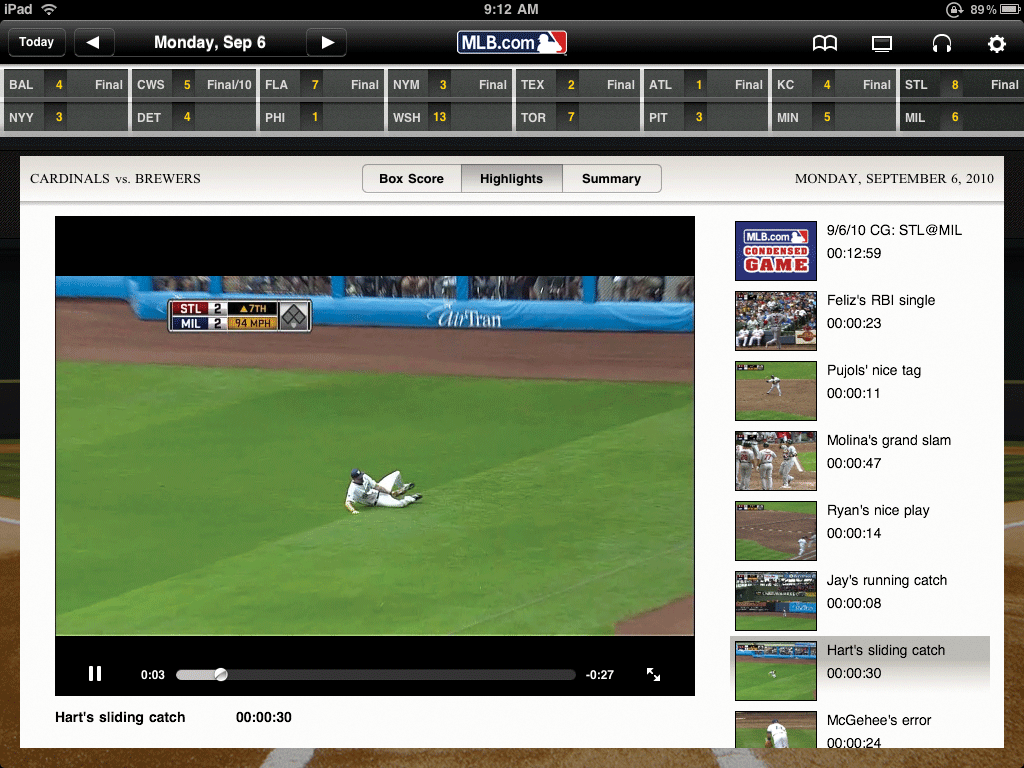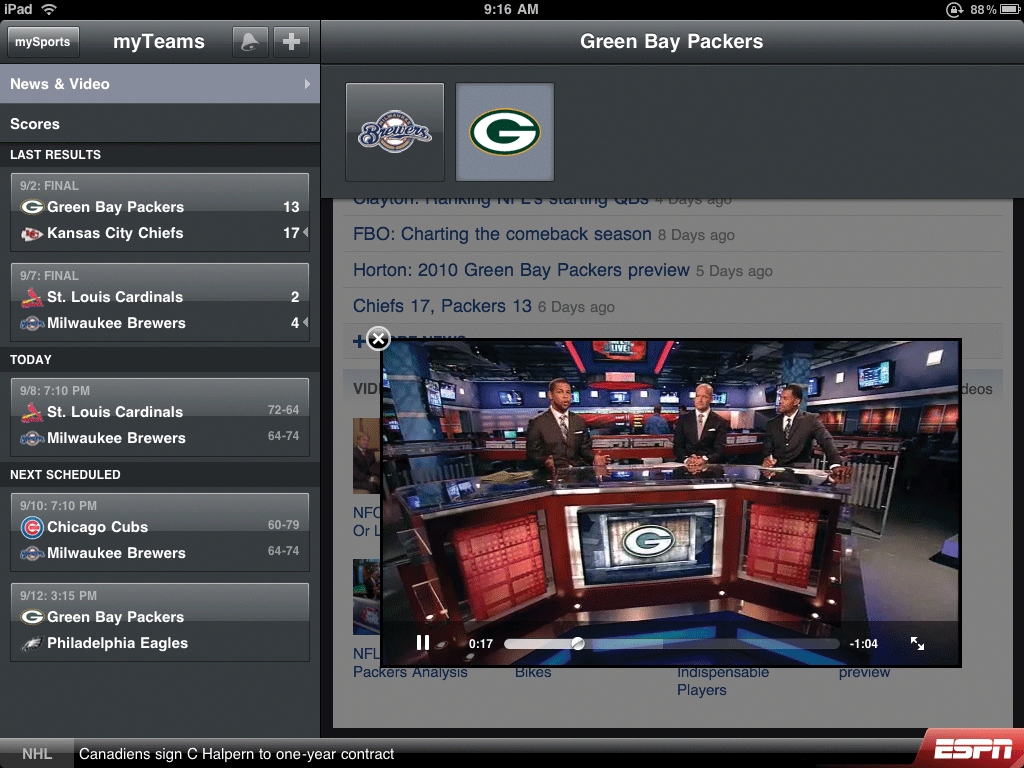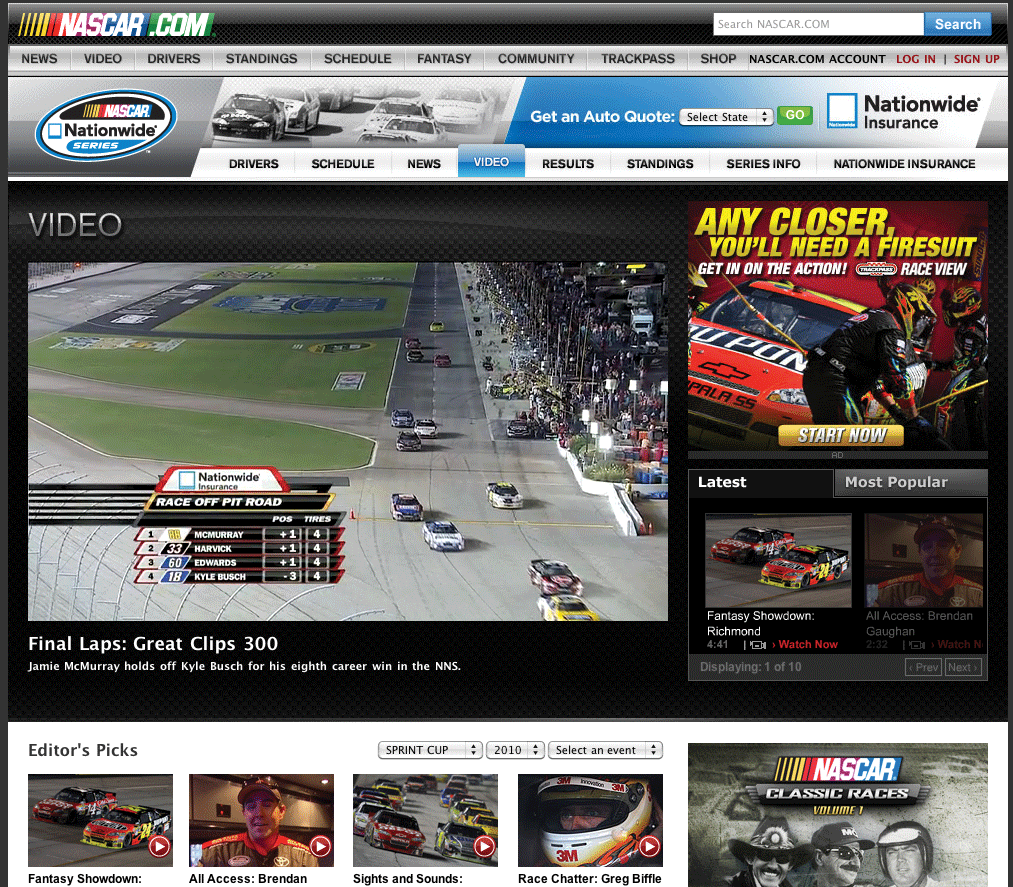Gentlemen, Start Your Streams
The Gold Standard
The aptly named Major League Baseball Advanced Media (MLBAM) is the gold standard for live sports streaming. In addition to MLB games and national events, its staff of 500 sprawled over several floors in New York’s trendy Chelsea Market complex also acts as subcontractors for live streaming work for other leagues’ events, such as college basketball’s March Madness. The workflow—taking in HD signals from the league or another network and sending it to the banks of Inlet encoders before passing it along to the various cellular and other distribution channels—is pretty straightforward, says Joe Inzerillo, MLBAM’s senior vice president of multimedia and distribution, who is widely acknowledged as a premier guru of live sports streaming by his peers. But, he adds quickly, “The devil is in the details.”

Major League Baseball Advanced Media is considered the gold standard for live sports event streaming. Here’s a look at its MLB At Bat iPad app.
Inzerillo says that as the streaming sector has gravitated toward the H.264 codec, part of the MPEG-4 standard, complexity has grown as both H.264 and handset profiles have proliferated in types and iterations. “MPEG was smart in that they phased H.264 in, versus the sudden jumps between, say, MPEG-1 and MPEG-2 in the past. But as different profiles get released, it increased the level of complexity,” he says, which is further compounded by inherent data memory and CPU limitations of the mobile devices. “Having more flexibility as to what to implement for each profile was beginning to become more important.”
Then came Google’s Android phone, which uses WebM, an open web media format project that open sourced the VP8 web-optimized video codec, the legacy of Google’s acquisition of On2 and which is offered under a royalty-free license. The H.264 license isn’t royalty free, but Inzerillo says it’s economical enough given that it had offered the industry a standard that many streaming entities were adhering to for the sake of consistency. “We were getting close to a consensus,” Inzerillo sighs. The Flash media server also incorporates H.264. But Apple’s decision earlier this year not to include Flash in its iPad device further complicates the situation for streaming service providers, because Flash does not support the HTML5 standard that Apple is embracing. Inzerillo hopes to see standardization develop around HTML5 in the future. “For live sports streaming, HTML5 is a good thing; that’s where it needs to go.”
But other issues remain, including fluctuations in broadband pipes, which Inzerillo says are 10 times harder to deal with in mobile streaming than it is in a PC environment. Another issue is achieving sufficient scale to service all potential customers for high-profile sports events. Solutions include encapsulating streams using unique discrete packets to act as an advanced kind of buffering. Inzerillo’s team has also developed its own techniques to optimize the look of the video, for instance, using presets team members have tweaked to adjust the picture to the ambient light level at the sports venue.
“Live sports is about as tough as it gets for streaming to mobile devices,” he says. “Unlike a movie where you can pre-encode, sports has to get out fast, now. The value and relevance of the content comes from the fact that it’s live, and after 10 minutes, its value can plummet.”
An HD Universe
In many ways, the situation of the digital encoding operation mimics that of its counterparts on the cable and broadcast side. Just as the consumer reception of a network’s signal is dependent as much on the capabilities of a cable provider’s head end as it is on the quality of the signal itself, streamed content is vulnerable to artifacts such as latencies induced by the distributing ISP. “We’re not the final stage that everything goes through, so we can’t send out a lowest-common-denominator signal,” ESPN’s Zehr emphasizes, noting that cellular providers such as Verizon are the “last mile” for mobile devices. “We try to supply the best possible signal from our encoding farm, and then it’s up to them.”

ESPN has a variety of online video offerings, such as its Scorecenter iPad app, which at this point does not include live event video.
Network streaming providers such as ESPN and Turner Sports are certainly starting with good source material. Turner’s digital group in Atlanta is taking 1080i video and 48 kHz audio in an MP3 or AAC format (Turner is one of the few networks that are streaming in stereo) taken in from the network’s remote operations at event sites including NASCAR tracks and PGA courses. Incoming sports feeds are integrated with various interstitial programming, including commercials and network promo spots. These then pass through the encoder banks (“the farm” in local parlance) to render them compatible with various phone platforms and cellular provider networks.
“Each encoder is set up for a particular handset platform profile that automatically sets it up to encode for an iPhone, an Android, a BlackBerry, and so on,” Tom Sahara, senior director of production operations for Turner Sports, explains. Most of what takes place once the signals reach the encoder farms tends to be automatic—the result of plenty of programming ahead of time—as is distribution to the various carriers. But Sahara says there’s still a lot of management that has to go on. The diversity of handset profiles in the market is in contrast to broadcast sports in general, which are now shown almost universally in high definition at the major-network level. In some cases, each phone type might have multiple bitrate streams, if the carrier supports that. The best solution is to start with the highest quality signals possible. “Even if it’s on a 160x240 [resolution] handset screen, for instance, the quality is better if the source material is high-quality,” he says.
In fact, much of that happens in real time while the streamcasts are taking place. Turner has developed several approaches to mobile sports streaming for various leagues, including TNT RaceBuddy on NASCAR.COM, which acts as a streamed supplement to the NASCAR main event that Turner is broadcasting; it allows viewers to select one of four camera angles from which to view the race. Or TNT OverTime on NBA.com, a streamed service that lets viewers choose players to follow on their laptops as the game progresses on TV. But if the narrative is interrupted for whatever reason—a weather-related delay, for instance, or an extended referee huddling—the old “rain delay theater” standby of broadcast television does not apply to the streamed domain, which can’t simply cut away at a moment’s notice to another feed. “We have to set up in advance with the cellular provider what the process is going to be in the event of a delay,” says Sahara. “Either we have alternate material that we’re ready to switch to, or we put up a slate that says ‘rain delay’ or whatever. If there’s an agreement with the sponsor to do so, then some sponsored programming might go up. The nature of sports is that you don’t know what’s going to happen next, so you have to be ready to adapt to unexpected events.”

Turner Broadcasting has developed live video streaming arrangements with several leagues, including the NBA and NASCAR.
What viewers see will be dependent upon their handset, their carrier, and what mode their device is in. An iPhone or Android can be switched to a Wi-Fi mode, enabling the viewer to enjoy higher resolution and throughput. But with that many variables, there’s no way for the streaming providers to know exactly what everyone’s experience is going to be like. Turner, like other streaming operations, has a variety of handset profiles in the plant to use as monitors, and they rely on an ad hoc network of employees and friends—“the community,” says Sahara—to monitor each of the various streams and to report back to the team about any problems.
The Big Jump
Streaming content to computers has been a valid business since broadband became affordable. During the past decade, OS platforms and browsers have stabilized, with Apple’s OS gaining ground (thanks mainly to its mobile initiatives, however), but without undercutting Windows, and Flash emerging as the de facto standard for multimedia. High-bandwidth streaming via T1 and other pipes has made the transition to the HD environment fairly well, with Silverlight and other high-performance applications able to put 1080 across onto laptops pretty much intact (with 5.1 surround sound soon to follow). Throughput rates of about 700Kbps have become the norms, using the DSL rate as a guide. It’s a stable operating environment.
Migrating that content to mobile devices, on the other hand, is proving to be more like herding cats. Tony Fernandez, vice president of technology for CBSSports.com, which has streamed select college football games, basketball games, and PGA Tour tournaments, says inconsistencies in bandwidth rates for mobile devices plus the ever-growing array of phones and other devices and their form factors make mobile a moving target. “With computers, as long as you got PCs and Macs right, you were fine. But with mobile, everything depends on the type of network the device is on, the device itself, the OS, and the carrier,” he says. “It’s a very fragmented market.” The iPhone and other Apple devices have complicated things further, particularly the iPad and its absence of Flash, which necessitates the use of a specific app.
Mobile devices also need more attention from a management perspective because there is less real estate on the GUI for user controls and user-engaged add-ons, such as chat rooms. “The PC gave you the opportunity to create a truly immersive experience for the user,” says Fernandez. “The form factor of the mobile device is more limited.”
As many technical challenges as the streaming of live sports events presents, the business side of it is just as dense. “The rights for streaming sports to mobile devices are more exclusive and far less thought-out at this point than they are for the PC environment,” comments Tim Fitzpatrick, vice president of communications at the Comcast Sports Group, which has been streaming sports in a PC environment for some time, but it has yet to enter the mobile domain. “The rights issues vary considerably from league to league and even team to team. The media players are proceeding with caution because the future stakes are so great and the business models are not yet established.”
The future may be more of the same, with no end in sight of the proliferation of incompatible platforms and monkey wrenches such as a CDMA (code division multiple access) compatible iPhone running on a Verizon network that is rumored to be coming down the line. (Or, for that matter, rights issues getting as granular at the player level, in light of the amount of control LeBron James had over his July press conference, where he announced he was joining the Miami Heat. He and ESPN orchestrated an hour of broadcast and online hoopla—and paid commercials—for critical content that took all of 11 seconds to convey.) 4G will improve cellular performance, but available bandwidth issues will continue to plague an industry already on the verge of eliminating all-you-can-eat pricing in favor of a tiered model. And then there are the almost Zen-like questions, such as when Fernandez says, “The iPad—is it a mobile device or not? It’s as powerful as a laptop now. The lines between things used to be clear. Not anymore.”
Related Articles
The perfect solution is a year or two away, concludes Streaming Media West panel.
17 Dec 2011
Versatile viewing options and a wide range of content keeps baseball fans happy.
10 Feb 2011
The VP of emerging media for Turner Sports talks about the network's delivery of the PGA Championship online, as well as the benefits of HTTP streaming and the implications of HTML5 video
31 Dec 2010
NBA.com is streaming live video of training camps from the Atlanta Hawks, Boston Celtics, Denver Nuggets, Los Angeles Lakers, and Washington Wizards.
Wed., Sept. 30, by Tim Siglin
30 Sep 2009
HD sports streaming is taking off, and Inlet is behind many of the major events, including MLB, the Indianapolis 500, the Tour de France, and Wimbledon.
Thurs., Aug. 13, by Troy Dreier
13 Aug 2009
Fantastic Entertainment and GlobalMedia.com are the technology partners behind the initiative.
19 Oct 2000
Companies and Suppliers Mentioned